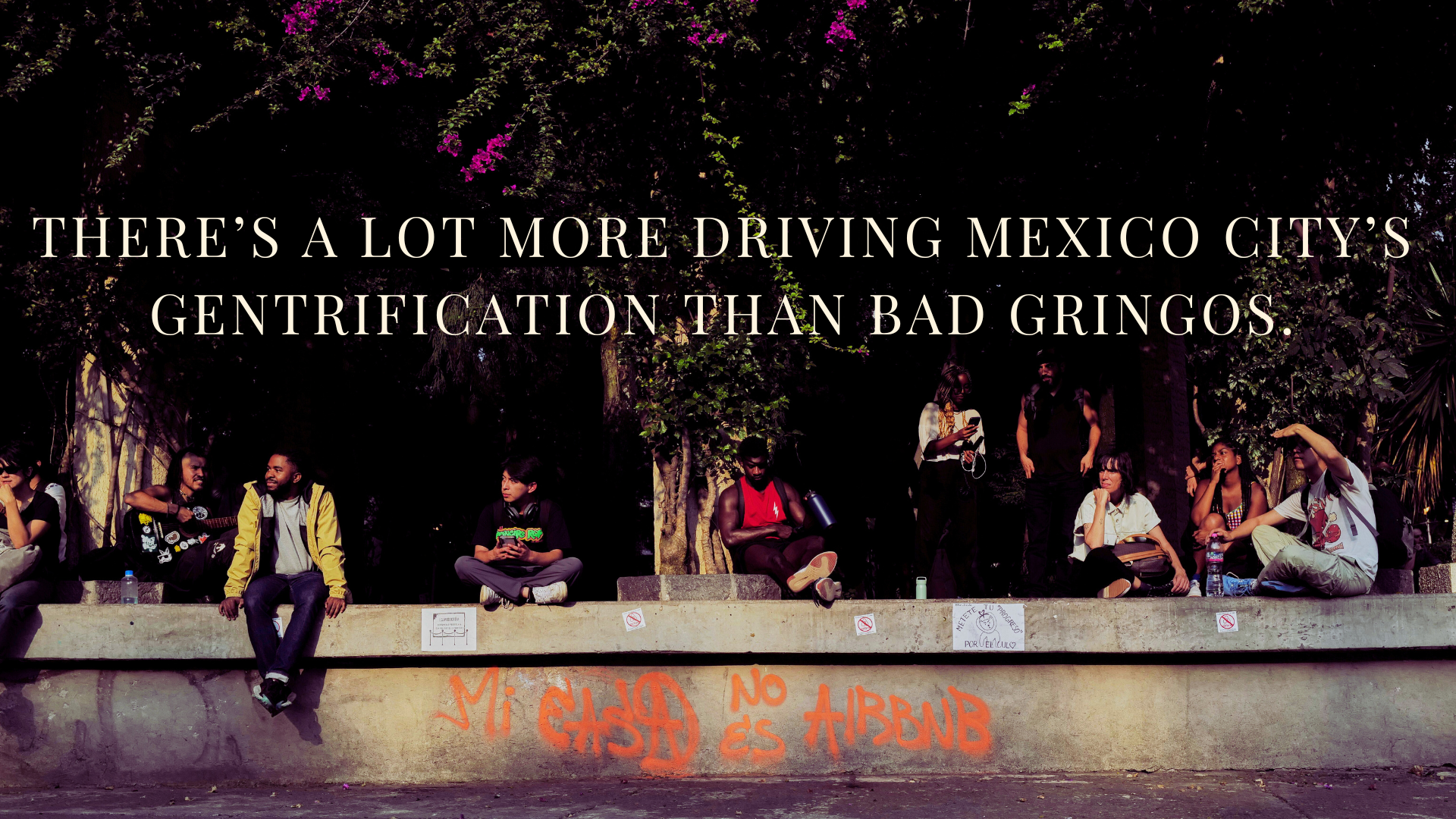
There’s a lot more driving Mexico City’s gentrification than bad gringos
by David Agren.
The acerbic signs and graffiti criticizing gentrification in Mexico City’s fashionable neighbourhoods were certain to capture international attention.
“Spanish is spoken here,” “Mexico for Mexicans,” and, “Go home,” read three of the screeds.
Social media couldn’t get enough of the disorderly protests – with the familiar masked vandals infiltrating yet another march and smashing up storefronts. The Mexico City police were curiously absent. An easy narrative of Americans abroad wearing out their welcome, while ICE cruelly rounded up Mexican migrants in cities such as Los Angeles.
The Department of Homeland Security jumped in with its own snark, posting, “Oh,” above an X Post with protester graffitiing the words, “Not your home,” and a protester waving a sign in English admonishing, “Pay taxes, learn Spanish, respect my culture.
Much of the international media, meanwhile, focused on the core matter of gentrification, which has spread through leafy neighbourhoods such as Roma, Condesa and Juárez – among others – over the past 15 years, driving up rents and forcing some long-term residents to move as their homes became short-term rentals.
The easy hook for any story on gentrification are…

Squatters, scaremongers, and the challenge of Mexico’s ghost homes
by Madeleine Wattenbarger.
A new housing program sparked indignation across Mexico’s mainstream media this week. With the initiative, the Institute for the National Housing Fund for Workers (Infonavit) will offer refinancing plans to people who have stopped paying off their Infonavit housing loans. It will also offer a rent-to-buy plan to squatters of abandoned Infonavit homes.
Establishment media figures in Mexico decried the program’s implications for private property in Mexico. El Heraldo radio host Luis Cárdenas insisted that the judicial reform would allow Morena to seize private dwellings. Speaking in a video posted to social, Cárdenas claimed, “The head of the Infonavit will turn over your house and mine to the criminals who squatted it.” The Infonavit has said that the measure only applies to homes that are not in dispute.
Speaking on Monday, Infonavit director Octavio Romero Oropeza explained that the program is an attempt for the government to recover social housing units without resorting to mass evictions. An ongoing Infonavit census has found 25,000 abandoned houses across the country. Local governments, concerned about them becoming a locus of crime, have long requested that the Mexican state do something about the empty developments.
According to Silvia Emanuelli, the Latin America regional director of the Habitat International Coalition, the UN’s housing organization, Mexico’s abandoned homes are a result of pro-market policies reproduced across the continent in the 1990s, with the logic first applied in Chile under the Pinochet dictatorship. Those policies mandated a reduction in the state’s role in the housing market. Private companies were put in charge of building housing, and homes became merchandise.

Development plans for Estadio Azteca bypass Indigenous consultation
by Madeleine Wattenbarger.
Next year’s World Cup will be the third to take place at the Estadio Azteca, which is located in the southern Mexico City neighborhood of Santa Úrsula Coapa. In preparation for the 2026 sporting event, Mexico City mayor Clara Brugada has announced a series of public works around Santa Úrsula, a historic indigenous town, one of dozens now absorbed by the metropolis. But the authorities have yet to carry out the indigenous consultation process required by the Mexican constitution and international law, and neighbors are concerned about the event’s toll on the area’s natural resources.
“In ‘70 and ‘86, there were a lot of people and a lot of money spent, but who took that money home? Here, they didn’t so much as paint a fence,” says Rubén Ramirez Almazan, the traditional authority figure of Santa Ursula’s indigenous governance structure. ”We aren’t against the project, but they have to do feasibility studies, and the people have to decide whether they do the projects or not.”
The plan includes an elevated bike lane from the Zocalo to the Estadio Azteca, a nine-mile stretch planned above the existing metro line, and a remodeling of the existing lightrail train.
“It’s concerning because we don’t have any information about the impact, if there’s any kind of program for security, waste management or the water supply,” adds Natalia Lara Trejo, a resident of Santa Úrsula. She’s one of a group of neighbors demanding more transparency around the World Cup preparations.

